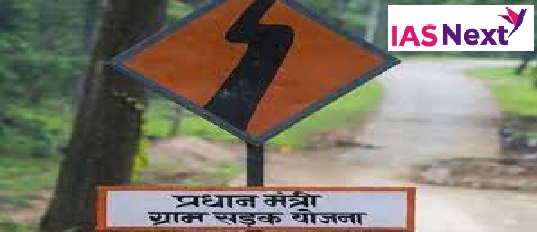CURRENT AFFAIRS
Get the most updated and recent current affair content on Padhaikaro.com
Pradhan Mantri Gram Sadak Yojana (PMGSY)
- IAS NEXT, Lucknow
- 19, Nov 2021

Reference News:
The Cabinet Committee on Economic Affairs has approved continuation of Pradhan Mantri Gram Sadak Yojana (PMGSY)-I and II up to September, 2022, and Road Connectivity Project for Left Wing Extremism Affected Areas up to March, 2023.
- The timeline has been extended to ensure works envisaged under the three schemes are completed.
Need for:
- Majority of pending works under PMGSY-I and II are in the North-East and Hill States due to factors such as COVID lockdown, extended rains, winters, forest issues.
- Also, the States have been requesting the Central Government for extension of time to complete these crucial works related to rural economy.
About PMGSY:
Launched on: 25th December, 2000.
Objective: To provide connectivity, by way of an all-weather road to unconnected habitations.
Eligibility: Unconnected habitations of designated population size (500+ in plain areas and 250+ in North-Eastern States, Himalayan States, Deserts and Tribal Areas as per 2001 census) in the core network for uplifting the socio-economic condition of the rural population.
Funding: The Union Government bears 90% of the project cost in respect of projects sanctioned under the scheme in North-Eastern and Himalayan States, whereas for other states the Union Government bears 60% of the cost.
PMGSY – Phase I:
- PMGSY – Phase I was launched in December, 2000 as a 100 % centrally sponsored scheme.
- Under the scheme, 1,35,436 habitations were targeted for providing road connectivity and 3.68 lakh km. for upgradation of existing rural roads in order to ensure full farm to market connectivity.
PMGSY – Phase II:
- The Government of India subsequently launched PMGSY-II in 2013 for upgradation of 50,000 Kms of existing rural road network to improve its overall efficiency.
- While the ongoing PMGSY – I continued, under PMGSY phase II, the roads already built for village connectivity was to be upgraded to enhance rural infrastructure.
Challenges:
- Lack of dedicated funds.
- Limited involvement of the Panchayati Raj Institutions.
- Inadequate execution and contracting capacity.
- Less working season and difficult terrain particularly in Hill States.
- Scarcity of the construction materials.
- Security concerns particularly in Left Wing Extremism (LWE) areas.
About the Road Connectivity Project for Left Wing Extremism Affected Areas:
Started in 2016, it is envisaged in LWE States including the 44 LWE affected districts in 9 States.
- The roads taken up under the scheme would include Other District Roads (ODRs), Village Roads (VRs) and upgradation of the existing Major District Roads (MDRs) that are critical from the security point of view.
- Bridges up to a span of 100 meters, critical from security angle would also be funded on these roads.